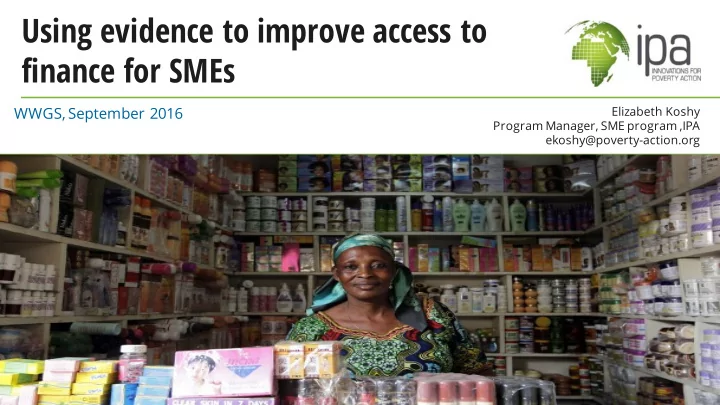

Using evidence to improve access to finance for SMEs WWGS, September 2016 Elizabeth Koshy Program Manager, SME program ,IPA ekoshy@poverty-action.org
The role of SMEs ü Key source of job creation and social mobility ü Hire and train low-skilled workers ü Market aggregators ü Multiplier effect ü Crucial to the development of strong, dynamic economies
Constraints to SME growth Access to finance Human capital and skills Access to markets Regulatory constraints Lack of infrastructure
But.. What works? Billions of dollars spent • annually to promote entrepreneurship Yet, little evidence on most • effective ways to address those barriers. There is need for innovation, experimentation and learning in the SME development space.
Innovations for Poverty Action Discovering and promoting effective solutions to global poverty problems The Problem IPA’s Solution
The SME program at IPA Discovering and promoting effective solutions to barriers that restrict SME growth in developing countries Over 100 studies across 33 countries Bridge the gap between research and policy Build the body of evidence Promote evidence based decision making
SME Program Research Agenda Access to markets and Human capital and skills Access to finance information Business training Innovative financial Export support products Mentoring Matching platforms Better screening Consulting services Value chain mechanisms development Business plan Alternative collateral competitions Government models procurement Matching grants
Access to finance Approximately 45-55% of MSME’s • are unserved or underserved Value of credit gap >2 trillion USD • SME’s are very dependent on • external financing Bank’s are reluctant to lend to • SME’s because its expensive and risky
SME’s face constraints along the entire lending cycle Screening Collateral Investment Repayment Featured study I: Featured study II: Featured study III: Featured study IV: Computer Flexible collateral in Financial literacy Relationship generated credit Colombia training in the DR banking in India scores in Colombia
SME’s face constraints along the entire lending cycle Screening Collateral Investment Repayment • Limited historical information • Incomplete financial records • No credit bureaus
Improving client screening Featured study: The impact of computer generated credit scores on lending in Colombia
Using computer generated credit scores for client screening Ø Reduce processing time and costs Ø Increase incentives of credit committee Ø But do you lose valuable “soft information”? Can a computer generated credit score reduce the bank’s cost and improve the quality of the bank’s loan review process
Studying the impact of computer generated credit scores Partnered with Bancamia, a bank in Colombia • Randomly assigned availability of score across loan applications in • 8 branches Experimental design: • Group A: Credit score given to committee prior to decision • Group B: Credit score given to committee after decision • Group C: Control Group, no credit score •
Computer generated scores improve efficiency of loan process Fraction of non decisions • drops by more than 40 percent with a credit score Committee spent more time • on harder to evaluate applications Effect mainly seen through • the incentive channel Information technology can • play a role in decentralized decision making
SME’s face constraints along the entire lending cycle Screening Collateral Investment Repayment • SME’S don’t have the type of collateral required by banks
Using movable assets as collateral New secured transaction reform in Colombia in association with • IFC and Colombian government Ability to use movable collateral such as vehicles, machinery, • accounts receivable etc. Reform includes • Unified online registry • Increased enforcement in the case of default • What is the impact of the reform on lender’s and on SME business outcomes?
SME’s face constraints along the entire lending cycle Screening Collateral Investment Repayment • Many business owners unprepared to make business decisions
Improving financial management of SMEs Featured study: Keeping it simple – Financial literacy and rules of thumb for micro-entrepreneurs
Training micro-entrepreneurs in financial literacy Strong association between improved understanding of financial concepts and outcomes Evidence on success of training programs is mixed Can training programs improve financial practices and outcomes? How can financial training be taught more effectively
Studying the impact of “rules of thumb” training Partnered with a microfinance institution (ADOPEM) in the • Dominican Republic Randomly assigned training opportunity across 1,200 clients • Experimental design: • Group A: Traditional accounting training • Group B: Rules-of-thumb training • Group C: Control Group, no training •
“Rules of thumb” training more effective than traditional training “Rules of thumb” trainees were 6 to • 12 percentage points more likely to separate business and personal cash More effect on less sophisticated • clients Better revenue particularly in bad • weeks Financial training programs can work. One size does not fit all when it comes to training
SME’s face constraints along the entire lending cycle Screening Collateral Investment Repayment • Higher default rates compared to larger borrowers
Improving repayment rates Featured study: The personal side of relationship banking
Using relationship banking to reduce default rates ü Creates more personal responsibility for client ü Gathers more “soft information” on the client Can a personal relationship between the lender and borrower lead to lower default rates without increasing lending cost?
Studying the impact of relationship banking Partnered with a ICICI Bank in India • Randomly assigned increased interaction across 1319 loans • Experimental design: • Group A: Personal touch treatment Group B: Medium touch treatment Group C: Reminder treatment Group D: Control Group
Personal interaction improves loan repayment Groups A and B had .1 fewer late • payments compared to D. Reduction in the number of multiple • delinquencies Improved customer satisfaction • Additional cost compensated by • reduced late payments No difference between high and • medium touch groups. Personalized attention is sufficient
Conclusion Small tweaks can have material impact • But, many questions still remain • Rigorous evidence can point us to the most • effective ways to help SME’s improve their access to finance Strong research partnerships are key to • ask the right questions and make sure results are implemented
THANK YOU ekoshy@poverty-action.org www.poverty-action.org/sme
Recommend
More recommend